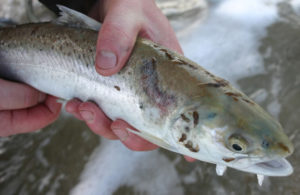Wild Salmon. Part 1

Three months after starting this blog for the parishioners of St. Margaret’s Church, Annapolis, to introduce them to the LEED 3rd-party rating system for sustainable buildings and to greener living, I wrote a post which had the most number of views in a single day of everything published before or since.
It was called “Things I’ve Forgotten or Never Knew about Trees, Wood—and the Atmosphere.”
For some time I’ve been interested to learn what topics appear to be of greatest interest to you. Answer: the environment, generally, and habitat a bit more specifically. Still broad, admittedly.
But I’m thinking about posts written about the oceans, and human-derived climate degradation and its manifold effects on biodiversity. About hiking. And about hallowed ground.
Sustainable growing/harvesting and farm-to-table-related have drawn many eyes as well.


Among things I learned while on vacation in the PacNW about 10 days ago-
- how wild salmon “inform” the growth of trees, and
- the danger of salmon farming on wild salmon (Part 2 next week)
Neither topic did I know anything about before our trip. (But, that’s largely the point of this blog—learning what I don’t know yet about sustainable buildings and the environment, then sharing for the possibility that you didn’t know it either; or have forgotten.)
 I was exposed to the salmon topics by 2 naturalists on our San Juan Safaris search for Transient Orcas. (Yes, we found ‘em just inside Canadian waters.)
I was exposed to the salmon topics by 2 naturalists on our San Juan Safaris search for Transient Orcas. (Yes, we found ‘em just inside Canadian waters.)
One was Erik Dowell who blogs about his work. Another on the search that day was Sarah. Great youth with great passion for nature. And such respect for it.
 Salmon and Trees
Salmon and Trees
Sarah or Eric told me about how salmon provide for healthy forests around their habitats. Really?
Rings in trees cut or knocked down evidence greater or lesser growth year after year, as we know. But there’s a correlation between tree growth and salmon spawning/dying cycle in PacNW waters and further into British Columbia.
“Every year, as millions of fish return to spawn and die in rivers in the Pacific Northwest, they provide a bonanza for bears, eagles, and other species,” say University of Washington professors J. M. Helfield and R. J. Naiman in a study published in 2001. (The study was initiated because salmon stocks in the PacNW were falling alarmingly.)
“After a quick bite on the head to kill the fish, the bears drag their prey back into the forest, where they can feed undisturbed.”
But did you know this? “Bears don’t eat everything they catch. They leave about half of each carcass to be scavenged by eagles, martens, crows, ravens and gulls.” After most is consumed, the bony remains start decaying, providing nutrients to trees.
An ecologist cited in the study asserts that some 120 kg of nitrogen/hectare of forest is produced along salmon-spawning rivers. Multiplied by the bear population of British Columbia, as much as 60 million kg (over 66K tons) of salmon tissue is being transferred into rain forests there annually. Salmon-derived nitrogen has been studied and documented in northwestern Oregon too.
Wondering how ecologists know that trees absorb nitrogen from salmon versus terrestrial sources? The answer might be more than the average reader here has the time to find out, but analyzing different kinds of nitrogen atoms is the basis of it. (For more, see here.)
“Tree ring studies show that when salmon are abundant, trees grow up to three times as fast as when salmon are scarce.” And, “Nearly 50 percent of the nutrients that juvenile salmon consume comes from dead parents.”
For purposes here, the wrap on Part 1 of this topic is:
“Biologists argue [that] forest, wildlife, and fish management need to be integrated. Each population—rainforest trees, bears, hatchlings, and ocean-going fish—affects the stability of the others. Salmon need healthy forests and streams to reproduce successfully, and forests and bears need abundant salmon. Stream ecosystems need standing trees to retain soil and provide shade.”
Mixing Farm-raised Salmon in Rivers and Streams Inhabited by Wild Salmon (Part 2)
Erik told me that farm-raised salmon threaten the health of wild salmon. I confessed rather sheepishly that I thought farm-raised salmon came from large ponds in some place like Idaho (inland) rather than in the same rivers as those inhabited by wild salmon (coastal).
Please return to the blog mid-next week for the rest of Part 2.
P.S. Upcoming is a post about the world’s most sustainable commercial building which I toured recently.